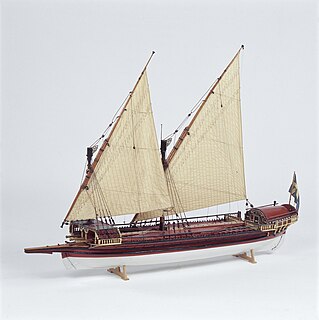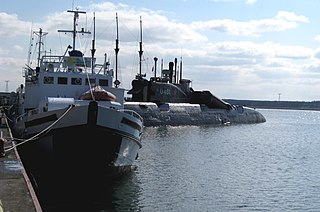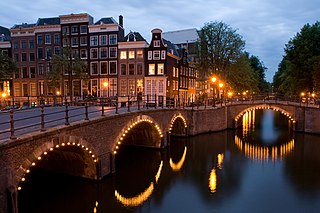The Russo-Swedish War of 1741–1743 was instigated by the Hats, a Swedish political party that aspired to regain the territories lost to Russia during the Great Northern War, and by French diplomacy, which sought to divert Russia's attention from supporting its long-standing ally, the Habsburg monarchy, in the War of the Austrian Succession.

Peter Jansen Wessel Tordenskiold, commonly referred to as Tordenskjold, was a Norwegian nobleman and an eminent naval flag officer in the service of the Royal Dano-Norwegian Navy. He rose to the rank of Vice-Admiral for his services in the Great Northern War. Born in Trondheim, Peter Wessel travelled to Copenhagen in 1704, and was employed in the navy. He won a name for himself through audacity and courage, and was ennobled as Peter Tordenskiold by King Frederick IV in 1716. His greatest exploit came later that year, as he destroyed the supply fleet of Charles XII of Sweden at the Battle of Dynekilen. In 1720, he was killed in a duel. In Denmark and Norway he is among the most famous national naval heroes. He experienced an unusually rapid rise in rank and died when he was only 30 years old.

General admiral was a Danish, Dutch, German, Russian, Portuguese, Spanish and Swedish naval rank. Its historic origin is a title high military or naval dignitaries of early modern Europe sometimes held, for example the (nominal) commander-in-chief of the Dutch Republic's navy.

Frank Friday Fletcher was a United States Navy admiral who served in the late 19th and early 20th centuries. He was awarded the U.S. military's highest decoration, the Medal of Honor, for his actions as commander of navy forces at the Battle of Veracruz, Mexico. The Fletcher-class destroyer, the most produced class of United States Navy destroyers, was named after him. He was also the uncle of Frank Jack Fletcher, another U.S. Navy Admiral who also received the Medal of Honor for actions at Veracruz, and who commanded U.S. naval forces at the battles of Coral Sea and Midway during the Second World War.

Admiral is a naval rank in Sweden. According to current practice only royals and the Supreme Commander of the Swedish Armed Forces, if he were to come from the Swedish Navy, can hold the rank of a full, four star, Admiral (amiral) in Sweden. The lower admiral's ranks currently existing are: Vice admiral, Rear admiral and Rear admiral /Flotilla admiral. The rank of Rear admiral /Flotilla Admiral was added on 1 July 2000, and simultaneously promotions to the rank Kommendör av 1. graden were discontinued. One to three star admirals are all addressed as "admiral" in daily speech.

The Battle of Gangut took place on 27 JulyJul./ 7 August 1714Greg. during the Great Northern War (1700–21), in the waters of Riilahti Bay, north of the Hanko Peninsula, near the site of the modern-day city of Hanko, Finland, between the Swedish Navy and Imperial Russian Navy. It was the first important victory of the Russian fleet in its history.

The Battle of Viborg Bay was a naval battle fought between Russia and Sweden on July 4, 1790, during the Russo-Swedish War (1788-1790). The Swedish Navy suffered heavy losses, losing six ships of the line and four frigates, but Gustav III of Sweden eventually ensured a Swedish naval escape through a Russian naval blockade composed of units of the Baltic Fleet, commanded by Admiral Vasili Chichagov. The battle ranks among the world's largest historical naval battles and also among the most influential, as it introduced the naval battle concept of "firepower over mobility".

Eduard Karl Emanuel von Jachmann was the first Vizeadmiral of the Prussian Navy. He entered the navy in the 1840s after initially serving in the merchant marine. In 1848, Jachmann received his first command, the corvette SMS Amazone; through the 1850s and early 1860s, he held several other commands, including the frigates Thetis—aboard which he took part in the Eulenburg expedition to East Asia—and Arcona. During the Second Schleswig War in 1864, he commanded Prussian naval forces in the Baltic from Arcona, and led a small squadron at the Battle of Jasmund on 17 March. Though defeated in that battle, he was promoted to Konteradmiral for his aggressive handling of the Prussian fleet.

Clas Larsson Fleming was an Admiral and administrator involved in the development of a formal management structure for the Royal Swedish Navy under King Gustav II Adolf and Queen Christina. He is remembered as one of the ablest administrators in the history of the Swedish navy, and is in many ways a typical example of the type of aristocrat who served the Swedish Crown during the period of Sweden's imperial expansion.
Count Ivan Fedoseevich Botsis was a Russian admiral and one of the founders of the Imperial Russian Navy under Peter the Great.

Olof Rudolf Cederström was a Swedish naval commander. Cederström enlisted in the Swedish admiralty in 1779. As captain, he conducted a raid against Rogervik, and distinguished himself in 1790 at the naval Battle of Reval and the Battle of Viborg Bay. During the following years he led ships against English privateers in the North Sea. He was sent in 1801 to fight alongside the United States Navy in the Mediterranean during the First Barbary War. In 1808 his ships were sent to blockade Gotland in order to repel the Russian invaders. His last military action was against Denmark and France in 1813, when he helped Swedish forces capture Vorpommern. In 1815 he was appointed a minister, but returned to the navy in 1818, and resigned in 1828.

Olof Strömstierna (1664–1730) was a Swedish naval officer and admiral. He was born as Olof Knape but became ennobled under the name Strömstierna in 1715.

A pojama or pojema was a type of warship built for the Swedish archipelago fleet in the late 18th and early 19th centuries. It was developed for warfare in the Archipelago Sea and along the coasts of Svealand and Finland against the Russian navy. The pojama was designed by the prolific naval architect Fredrik Henrik af Chapman for use in an area of mostly shallow waters and groups of islands and islets that extend from Stockholm all the way to the Gulf of Finland.

An udema was a type of warship built for the Swedish archipelago fleet in the late 18th and early 19th centuries. It was developed for warfare in the Archipelago Sea in the Baltic and along the coasts of Svealand and Finland against the Russian navy. The udema was designed by the prolific naval architect Fredrik Henrik af Chapman for use in an area of mostly shallow waters and groups of islands and islets that extend from Stockholm all the way to the Gulf of Finland.

A turuma was a type of warship built for the Swedish archipelago fleet in the late 18th century. It was specifically developed for warfare in the Archipelago Sea and along the coasts of Svealand and Finland. The turuma was designed by the prolific naval architect Fredrik Henrik af Chapman for use in an area of mostly shallow waters and groups of islands and islets that extend from Stockholm all the way to the Gulf of Finland.
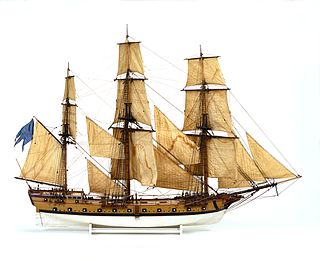
A hemmema was a type of warship built for the Swedish archipelago fleet and the Russian Baltic navy in the late 18th and early 19th centuries. The hemmema was initially developed for use against the Russian Navy in the Archipelago Sea and along the coasts of Svealand and Finland. It was designed by the prolific and innovative Swedish naval architect Fredrik Henrik af Chapman (1721–1808) in collaboration with Augustin Ehrensvärd (1710–1772), an artillery officer and later commander of the Swedish archipelago fleet. The hemmema was a specialized vessel for use in the shallow waters and narrow passages that surround the thousands of islands and islets extending from the Swedish capital of Stockholm into the Gulf of Finland.
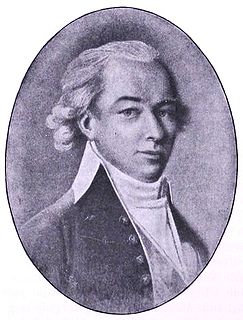
Baron Salomon Maurits von Rajalin was a Swedish Navy admiral and civil servant.

Magnus (Måns) Rosén von RosensteinnéAurivillius was a Swedish Navy rear admiral. After having served in the Fleet of the Army, Rosenstein joined the Royal Navy in the American Revolutionary War against the French. He then joined the French Navy and took part in the Battle of the Saintes where he was taken prisoner by his former commander Admiral Sir Peter Parker and was imprisoned in England. He was quit immediately released, returned to Sweden and would later distinguished himself in the Battle of Svensksund. Rosenstein retired with the rank of rear admiral in the Swedish Navy in 1797 and died in his hometown of Uppsala in 1801.

